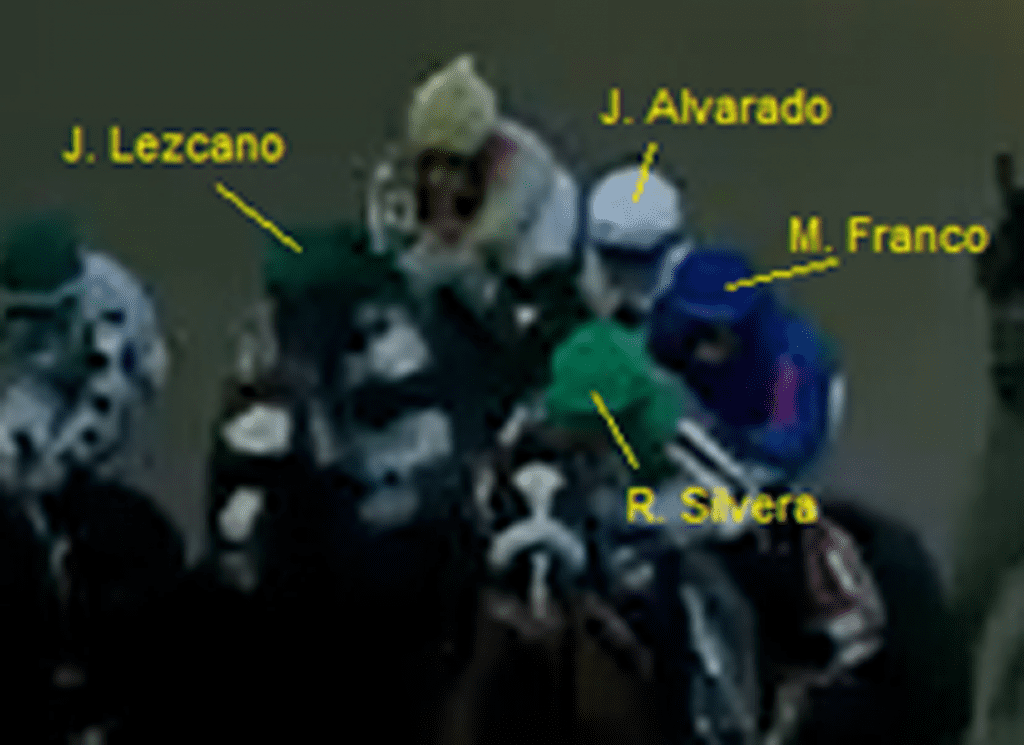The New York Gaming Commission issued a statement Friday regarding the controversial disqualification of Brick Ambush (Laoban) in the Dec. 16 Great White Way S. at Aqueduct that was meant to bolster the argument that the stewards made the right call, but it included a photo that could be construed as doing the exact opposite.
The TDN and other news outlets received an email from New York Gaming Commission Director of Communications Brad Maione that included six screen shots from the race taken at the point where there was contact and horses were steadied. One of the shots included arrows pointing to four jockeys, Ruben Silvera, Manny Franco, Junior Alvarado and Jose Lezcano. Alvarado was aboard Brick Ambush, who, though disqualified after crossing the wire second and placed last, appeared to be free of the trouble while racing outside and clear of the horses who were bothered. The arrow pointing to what was supposed to be Alvarado's mount was instead The Big Torpedo (Big Brown), who was ridden by Javier Castellano.
When the TDN notified Maione that there was an error concerning the identification of the horses and their riders, he sent a new version of the original statement that fixed the mistake. However, with Alvarado now properly identified, the pictures offered no evidence that he was at fault.
The second version of the statement included the following explanation: “Please note the first screenshot in the previous version incorrectly identified the riders on specific horses. Please disregard those reference screenshots. Corrected versions are attached and included below. The narrative remains unchanged.”
The disqualification set off a controversy that has yet to die down and the consensus in the sport is that, for whatever reason, the stewards simply DQ'd the wrong horse by mistake. Many believe that the horse that caused the bumping and deserved to come down was actually the race winner, Antonio of Venice (Laoban).
The statement made the case that the stewards carefully reviewed the race after the decision was made to disqualify Brick Ambush and that they stood by their decision. The stewards officiating the race were Braulio Baeza, Jr. (N.Y.S. Gaming Commission), Juan Dominguez (The New York Racing Association, Inc.) and Samantha Randazzo (The Jockey Club).
“The three Stewards' attention was focused on the field as it arrived near the quarter-pole, where several horses converged and were in close contact,” the statement read. “As evident in the below/attached screenshots, horse Brick Ambush (#12), ridden by Junior Alvarado, came up on three horses that were crowded together–Antonio of Venice (#1) ridden by Manuel Franco, The Big Torpedo (#7) ridden by Javier Castellano, and Solo's Fury (#11), ridden by Jose Lezcano–and made disruptive contact. The Stewards were concerned that Castellano's contact with the other horses and their riders could have impacted the results of the race.”
According to the statement, the stewards examined six separate camera views of the area of concern and conducted telephone interviews with Franco, Castellano, Lezcano and Alvarado. Castellano told reporters after the race that he attempted to claim foul, but the stewards have said they were unaware that he wanted to file an objection.
“After review of the footage and interviews with the jockeys, the Stewards unanimously concluded that Alvarado's movement of Brick Ambush to the inside at quarter-pole pole caused a chain reaction that impacted the race. Accordingly, the Stewards disqualified Brick Ambush for interference,” the statement continued.
Alvarado was hit with a three-day suspension for careless riding.
“The following morning, all four jockeys were required to participate in a film review of the race and discussed the event with all three Stewards,” the statement continued. “At the conclusion of the review, State Steward Baeza issued a 3-day careless riding suspension to Mr. Alvarado, to be effective January 1 through January 5, 2024. Mr. Alvarado accepted the penalty and declined to appeal.”
The post New York Gaming Commission Issues Update On Great White Way Stakes DQ, But Only Adds To The Confusion appeared first on TDN | Thoroughbred Daily News | Horse Racing News, Results and Video | Thoroughbred Breeding and Auctions.

